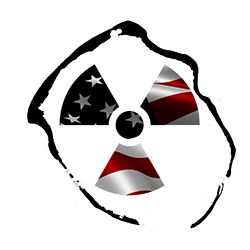The Chronology of the Marshall Islands : World War One to the Present Day
1919-1943 – Japan governs the Marshall Islands under the League of Nations South Pacific Mandate. In these years Japan was largely able to administer the islands as if they were colonial possessions, keeping their waters off limits to foreigners. During the 1930’s Japan begins to build military bases in the Marshalls.
 December 7, 1941 – Japan uses Kwajalein as the primary support base for the attack on Pearl Harbor.
December 7, 1941 – Japan uses Kwajalein as the primary support base for the attack on Pearl Harbor.
December 8, 1941 – The US enters the war.
September 1942 – Marks the inception of the Manhattan Project, initially to build the atomic bomb before German scientists can reach that milestone.
December 1942 – Enrico Fermi attains the first sustained nuclear reaction in an atomic pile, under the squash court at the University of Chicago. In the months immediately after, the Manhattan Project would become a massive engineering endeavor, spread out over the entire country under the directorship of Lesley Groves who would travel the nation with a mandate from the president, and tremendous authority with which to get the bomb made; he has an almost unlimited budget.
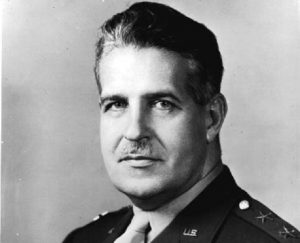 Lesley Groves 1942 – 1945 – Groves travels to Tennessee in early 1942 to establish The Oak Ridge Laboratory, through eminent domain, uprooting many families and taking their land. The Clinton Pile here is first genuine plutonium manufacturing facility in the country and begins production in November 1943.
Lesley Groves 1942 – 1945 – Groves travels to Tennessee in early 1942 to establish The Oak Ridge Laboratory, through eminent domain, uprooting many families and taking their land. The Clinton Pile here is first genuine plutonium manufacturing facility in the country and begins production in November 1943.
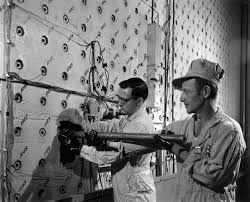 Oak Ridge Reactor
Oak Ridge Reactor
1943 – 1945 – A second plant is built in Richland, Washington called the Hanford Reservation. The first reactor goes on-line in September 1944. (Incidentally, a Superfund site now – it’s one of the most dangerous places on Earth)
November 1943 – February 1944 – Some of the fiercest fighting of World War II occurs in Majuro, Kwajalein and Enewetak as the Americans utilize an island-hopping campaign to drive the Japanese forces out of Micronesia. These atolls were the least heavily defended by the Japanese Navy but the most strategically important islands from an American standpoint. Majuro fell to the Americans after just one day, January 31st, 1944. The same day saw the beginning of the US assault on Kwajalein, considered the most important strategic goal. The atoll was pounded from both air and sea. It fell in four days. Kwajalein is the largest coral atoll in the world with a lagoon measuring 324 sq. miles. This attribute alone makes it one of the most desirable strategic locations in the entire Pacific. Japan regarded the atolls as stationary aircraft carriers. There is a US missile base on the atoll to this day. More on that later.

February 17, 1944 – First day of the Battle of Enewetak begins with a naval bombardment under operation Catchpole. Anticipating this, the Japanese forces had prepared by digging deep spider holes and bunkers. Despite early chaos among US forces, the atoll falls just six days later, marking the end of the campaign in the Marshall Islands. The same day, US forces destroy the Japanese base at Truk Lagoon in the Caroline Islands.
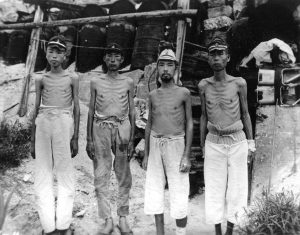
June 15, 1944 – The US invades Saipan in the Mariana Islands, trying to dislodge Japanese forces dug in there. Four days later the US shoots down 220 Japanese fighters in one day.
July 19, 1944 – US Marines invade Guam. Fierce fighting ensues but Guam is liberated eight days later.
October 23-26, 1944 – The Battle of Leyte Gulf decimates the bulk of the Japanese navy.
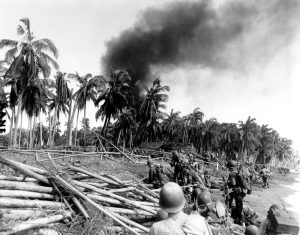
December 17, 1944 – The U.S. Army Air Force begins preparations for dropping the Atomic Bomb by establishing the 509th Composite Group to operate the B-29s that will deliver the bomb.
February 19, 1945 – The US invades Iwo Jima, one of the pivotal battles of the entire war.
March 9-10, 1945 – B-29 bombers firebomb Tokyo. 15 sq. miles of the city go up in flames. The firestorm it created is calculated to have killed 100,000 people and injured as many as a million. 
April 1, 1945 – The US Tenth Army invades Okinawa.
May 8, 1945 – VE day
July 10, 1945 – Bombing raids on mainland Japan and islands begin.
July 16, 1945 – Trinity Test, Alamogordo. J Robert Oppenheimer and his Manhattan Project scientists explode the first atomic weapon high in the New Mexico desert.
Trinity Test, Alamogordo
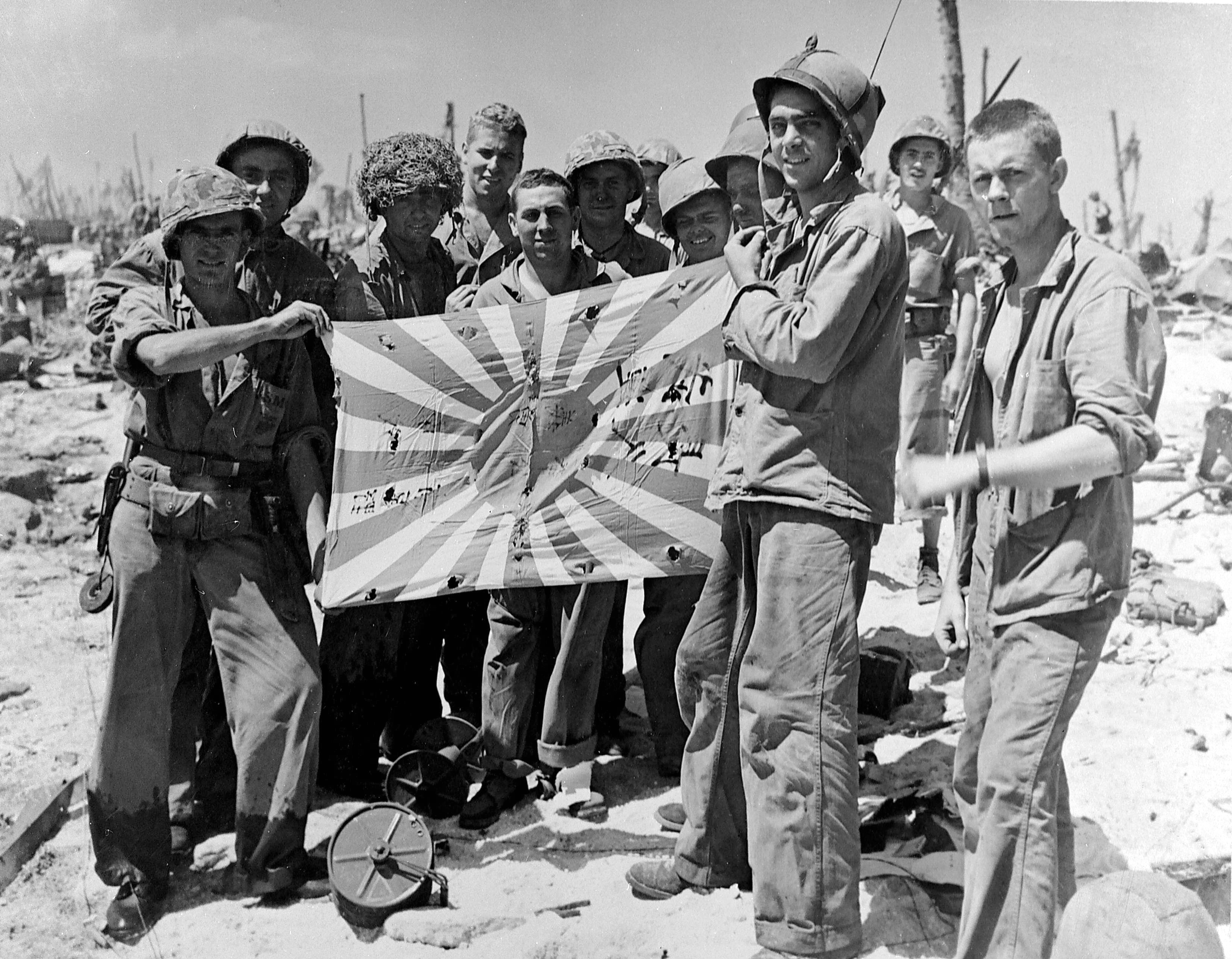
July 26, 1945 – Just ten days later the components for Little Boy, the bomb to be dropped on Hiroshima, are flown to Tinian in the Mariana Islands and assembled there.
A number of scientists had argued for a non-military demonstration of the power of the bomb for the Japanese authorities in the hope that they would capitulate and so making the destruction of Hiroshima and Nagasaki unnecessary. The idea was eventually dropped.
August 6, 1945 – Little Boy is dropped on Hiroshima by the B-29 Enola Gay resulting in the immediate deaths of 70 – 80,000, including about 20,000 Korean slave laborers. 12 American airmen imprisoned at the military police headquarters also died in the blast. Another 70,000 were injured, many of whom would die years later from radiation poisoning and resultant cancers. Within a mile of the ground zero there was total devastation. An area of 4.5 sq. miles erupted in a firestorm.
A Japanese soldier walks through the ruins of Hiroshima
August 9, 1945 – The B-29 Bockscar drops the Fat Man weapon on Nagasaki. Little noted is that Nagasaki was actually the secondary target, the primary one being the city of Kokura. Bad visibility there forced the Bockscar crew to fly on to Nagasaki. Mitsubishi had several factories including an arms manufacturing facility in the city making it a good strategic target. Between 22,000 and 75,000 people died immediately in the blast. Unlike Hiroshima, Nagasaki had a more old-world, traditional style of timber houses and factories.

U.S. wartime censors kept both Hiroshima and Nagasaki off limits to journalists until mid-September, a good month after the bombs were delivered. George Weller, a Pulitzer prize-winning war correspondent gained access to Nagasaki soon after the bombing and wrote, “The war was ended, as we had reported, but the censorship was not. What the command wanted covered was the [POW] prison camps of northern Japan. . . . away from where the war had been decided a month earlier.” Violating the U.S. Government’s edict that declared all southern Japan forbidden to the press, Weller headed to the Japanese island of Kyushu; on September 6, 1945, he became the first known civilian Westerner to enter Nagasaki since its atomic bombardment, arriving four weeks after the nuclear assault. “When I walked out of Nagasaki’s roofless railroad station, I saw a city frizzled like a baked apple, crusted black at the open core . . .”
“All concerned should feel a deep satisfaction at the success of the operations,” Brigadier General Thomas F. Farrell reported about the Nagasaki bombing in a memorandum to General Groves. But when the war ended a few days later at the Los Alamos atomic weapons laboratory in New Mexico, according to journalist Lansing Lamont, “more than one scientist walked cold sober into the dark of that August night and retched.
August 14, 1945 – The Japanese government accepts unconditional surrender. The US has seven bombs in the pipeline and is prepared to carry on bombing as long as the Japanese hold out but, with Russian forces making strong advances on the Japanese army in Manchuria, the decision is made.

September 2, 1945 – Formal Japanese surrender on board the battleship USS Missouri in Tokyo Bay.
September 8, 1945 – MacArthur enters Tokyo.
January 24, 1946 – Vice Admiral William H. P. Blandy, newly appointed head of Army/Navy Joint Task Force One, names the Bikini Lagoon as the site for the two 1946 detonations, Able and Baker. Of the possible places given serious consideration, including Ecuador’s Galápagos Islands, Bikini offered the most remote location with a large protected anchorage, suitable but not ideal weather, and a small, easily moved population. It had come under exclusive United States control on January 15, when Truman declared the United States to be the sole trustee of all the Pacific islands captured from Japan during the war. The Navy had been studying test sites since October 1945 and was ready to announce its choice of Bikini soon after Truman’s declaration.
February 6th, 1946 – The survey ship Sumner arrived at Bikini atoll and began blasting channels through the reef into the lagoon. The local residents were never told why.
February 10, 1946 – The 167 Bikini islanders first learned of their fate on this day when Navy Commodore Ben H. Wyatt, United States military governor of the Marshall Islands, arrived by seaplane from Kwajalein. Knowing the Bikinians to be deeply religious, Wyatt referred to biblical stories which they had learned from Protestant missionaries, he compared them to “the children of Israel whom the Lord saved from their enemy and led into the Promised Land.” He also claimed the tests would be “for the good of mankind” and “would end all world wars.” There was no signed agreement, but he reported by cable “their local chieftain, referred to as King Juda, arose and said that the natives of Bikini were very proud to be part of this wonderful undertaking.” On March 6, Wyatt attempted to stage a filmed reenactment of the February 10 meeting in which the Bikinians had joyfully given away their atoll. Despite repeated promptings and at least seven retakes, Juda confined his on-camera remarks to, “We are willing to go. Everything is in God’s hands.” The next day, LST-861 moved them and their belongings 128 miles East to the uninhabited atoll of Rongerik, to begin a permanent exile.
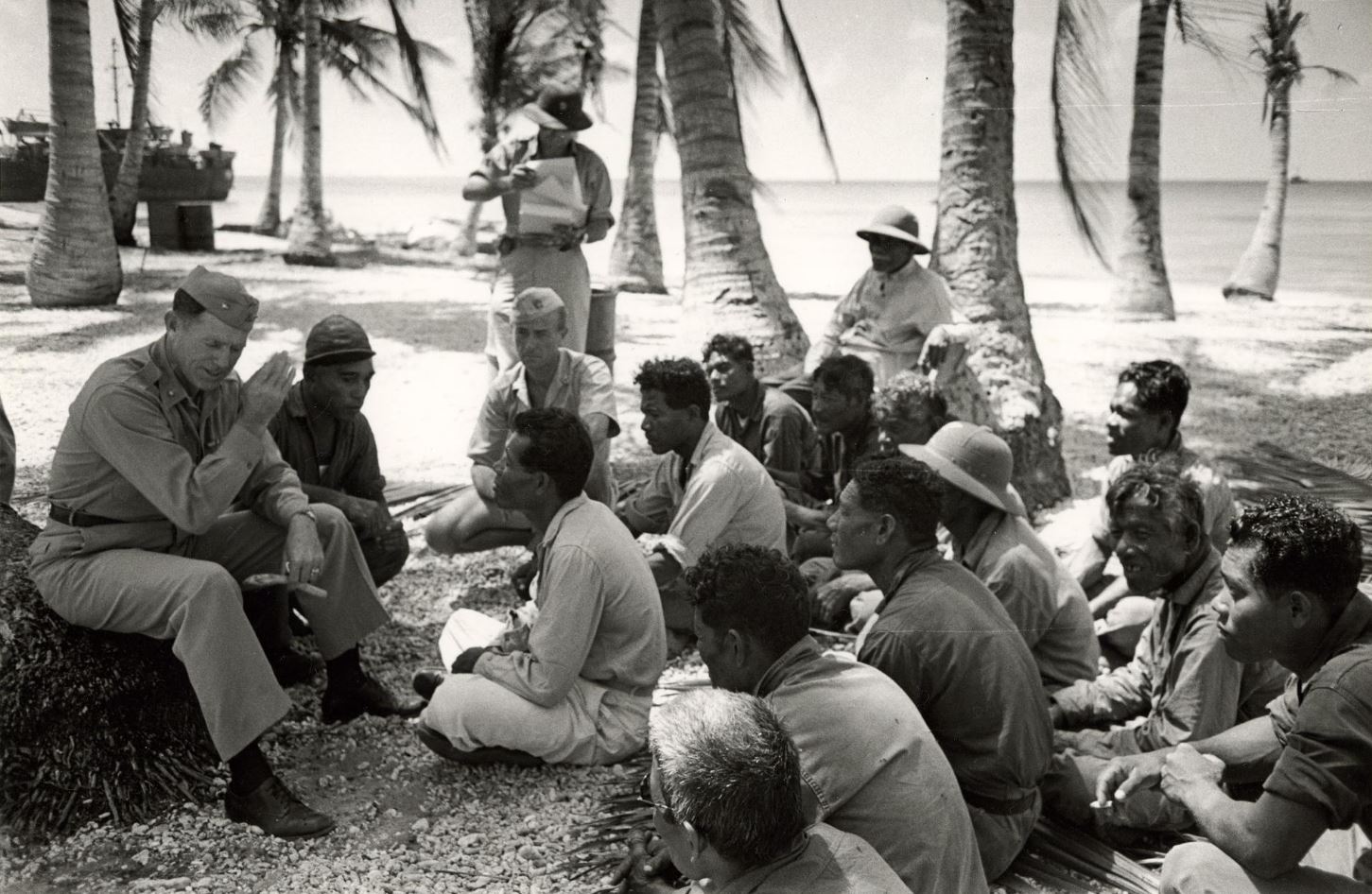 Commodore Wyatt addressing the Bikinian People
Commodore Wyatt addressing the Bikinian People
The Bikinian people are essentially dumped on Rongerik, which is sandy and infertile and left to fend for themselves. The atoll is a sixth the size of Bikini, just 0.65 sq. mile in total land area, and has inadequate sources of food or fresh water. There is also a long-standing belief among islanders that the atoll is inhabited by evil spirits, the Demon Girls of Ujae. This is the primary reason it had remained uninhabited.
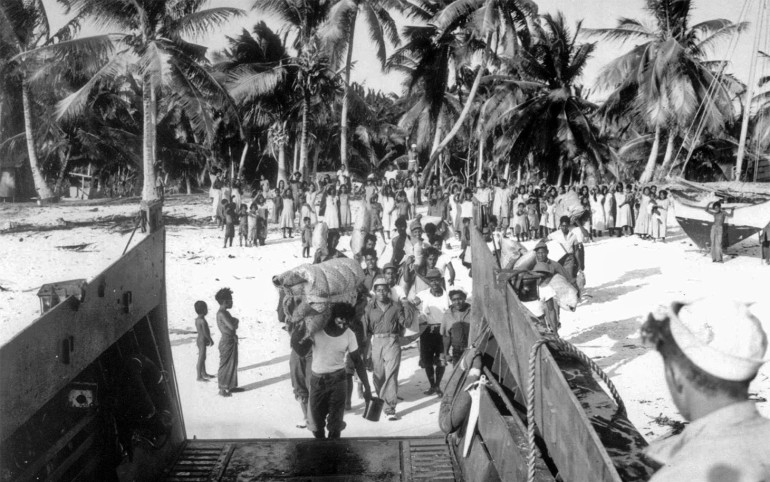
March 1946 – Winston Churchill gives his famous “Iron Curtain” speech, seen as a signpost marking the beginning of the Cold War.
July 1 – July 25, 1946 : Operation Crossroads, Able test, Bikini Atoll. The first test after Hiroshima and Nagasaki. A 23 kiloton weapon, code-named Gilda, is dropped from the B-29 Big Stink over an assembled fleet of 95 surplus and captured enemy ships. The bomb explodes over 700 yds wide of it’s intended target and sinks just 5 of the ships. Fifty-seven guinea pigs, 109 mice, 146 pigs, 176 goats, and 3,030 white rats had been placed on 22 target ships in stations normally occupied by people. The most famous survivor was Pig #311, which was found swimming in the lagoon after the blast and was brought back to the National Zoo in Washington, DC. It was determined that any crew members on these ships, even if they survived the blast, would have died of radiation poisoning.
Baker test. Baker is detonated 90 ft below the surface of the lagoon, suspended beneath landing craft LSM-60. It’s calculated that Baker lifted 2 million tons of water while creating a supersonic hydraulic shockwave, drenching all assembled ships and destroying many of them. The test severely irradiates the target ships and, despite efforts to decontaminate them, no such procedures had been tested in advance to see if they would work and to measure the potential risk to personnel. In the absence of a decontamination protocol, the ships were cleaned using traditional deck-scrubbing methods: hoses, mops, and brushes, with water, soap, and lye. The sailors had no protective clothing.
“Everybody was on a sort of a good attitude. I thought we were. I was. We thought this was wonderful the way they were treatin’ us there. And had all the ice cream we could eat. And we had some of this whatch-you-call-this 3-2 beer. And, uh, tryin’ to cool off with that.”
An unidentified Navy seaman who died of cancer in 1983, his extremities progressively amputated over the years due to massive unexplained swelling. He was part of the Crossroads Baker test decontamination crew.
-
At this juncture, the Marshall Islands have not yet been given United Nations’ Strategic Trust Territory status, which places them under US administration. This does not happen until July 1947. The Crossroads set of tests was therefore entirely illegal according to international law. This foreshadows the way the US will treat the Marshallese whilst under their trusteeship.
-
The requirements of the trust are as follows: Promote the development of the inhabitants of the trust territory towards self-government or independence as may be appropriate… and to this end shall . . . promote the economic advancement of the inhabitants . . . encourage the development of fisheries, agriculture, and industries; protect the inhabitants against the loss of their lands and resources.
December 1947 : The population of Enewetak is moved to the neighboring atoll of Ujelang to make way for the Operation Sandstone tests. Ujelang was to have been the next settlement site for the Bikinian people on Rongerik, so those people are without anywhere to live until they can be found a suitable habitat. Enewetak is large enough for an airport, a minor fact which doomed it to an unhappy fate.
April 14- May 14, 1948 : Operation Sandstone – testing shifts to Enewetak. Operation Sandstone comprises three tests, X-Ray (April 14th), Yoke (April 30th) and Zebra (May 14th). These were weapons design tests as opposed to effects tests. New designs were coming thick and fast as researchers looked at more efficient, more compact weapons.
March 1948 : Almost two years after their forced removal from Bikini, the people on Rongerik are near starvation and are evacuated to Kwajalein where they live in tents next to the airstrip and then on to Kili, a tiny island with no harbor or lagoon. It does have good soil and ample crops of coconut for export and trade. Their traditional lagoon fishing methods are no longer possible, however.
January 1951 : The 40-foot ship provided for the Bikinians by the administration is washed into Kili reef by heavy surf and sinks with a full load of copra. Due to rough seas and a shortage of vessels, food supplies on Kili run critically low on more than one occasion in the years between 1951 and 1953. Again, they are near starvation. At one point the situation becomes so critical that an airdrop of emergency rations is required. This happens again in 1960.
April 7 – May 4, 1951 : Operation Greenhouse comprises weapons tests Dog, Easy, George and Item, 81, 45, 225 and 44.5 kilotons respectively.
October 31- November 15th, 1952 : Operation Ivy. Ivy Mike, the first in this set is, at 10.4 megatons, by far the most powerful weapon on Earth… for now. Mike marked the first test of a genuine thermonuclear hydrogen bomb. It required the use of massive cryogenic apparatus to keep the liquid deuterium fuel cooled to near absolute zero, all of which had to be transported to Enewetak and erected on-site. The “weapon” was housed in a small building three stories high and weighed 82 tons so was impractical for use as an air-deliverable weapon but it proved the Teller/Ulam design was practical. Ivy King was intended as a backup in case Mike failed. It yielded a 500 kiloton explosion and was the most powerful fission weapon ever tested.
March 1 – April 22, 1954 : Operation Castle. Castle was split between Bikini and Enewetak but with just one test in the series actually being conducted on Enewetak. But this test series would have lasting repercussions on the entire republic. The first test, code-named Bravo, on Bikini, remains one of the most powerful and controversial explosions ever unleashed on Earth. The expected yield of this new dry hydrogen fueled weapon was between 4 and 8 megatons. It actually produced a yield of 15 megatons. Fallout from this test fell on Rongelap, the atoll to which the 167 inhabitants of Bikini had just been moved in order to make way for the test. With many planes and radio-controlled drones in the air to monitor wind speed and direction, many believe the test was purposely conducted to irradiate the Bikinian people and enable the study of the long-term effects of massive radiation poisoning on an unwitting populace. Details of a very dark program, labeled Project 4.1, emerge in later years which strongly suggest this is the case. Bravo vaporized three small islands, creating a crater in the coral wall almost a mile and a half in diameter and 250 ft deep. It can be seen from low Earth orbit. The mushroom cloud rushed up to 20 miles into the sky at 300 mph. Men aboard monitoring ships 40 miles away were forced to go below decks for greater protection. The highly radioactive vaporized coral traveled on high altitude winds and fell as a white “snow” on Rongelap, up to 2” deep. Not knowing what it was children and adults played in it, rubbed it on themselves and even ate it. The Lucky Dragon #5, a Japanese fishing ship is also covered in the snow. One of the crew becomes the first to die of radiation exposure some months later, creating an international incident. Bravo would kill every living thing for miles in every direction, birds, fish, sharks, crabs, and insects.
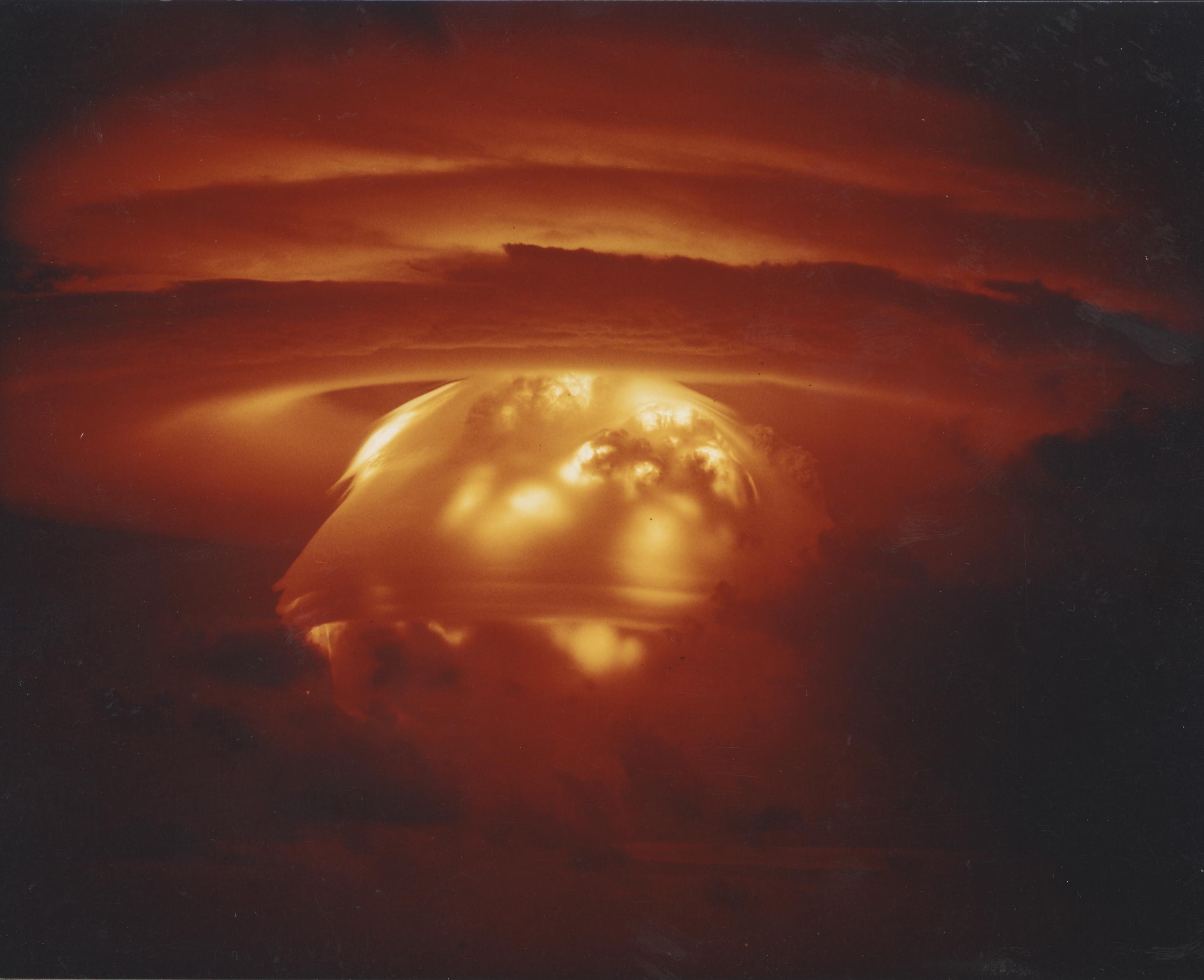
The US waits more than 48 hours before evacuating the people from Rongelap. By that time they were already suffering severe effects of radiation poisoning, nausea, rashes, bleached skin and falling hair. The people on Uterik had to wait an additional 24 hours for their rescue. They are all taken for observation to the naval base on Kwajalein.
‘On Rongelap, about two-thirds of the people developed anorexia and nausea and one-tenth had vomiting and diarrhea. In children aged under 5 years, 85% had nausea and 38% had vomiting, itching, and burning of exposed skin was noted by one-fourth of the people. Although the gastrointestinal symptoms lasted only about 2 days, skin burns appeared after 12 – 14 days in about 90% of the Rongelap inhabitants, with ulcerations in 15%. Epilation (loss of hair) occurred in 28% of the adults and in almost all children, in many of whom it was extensive.’
Radiation effects in the Marshall Islands by Jacob Robbins, William H. Adams
March 7, 1954 : a secret medical study, the “Study of Response of Human Beings Exposed to Significant Beta and Gamma Radiation due to Fallout from High Yield Weapons”, was established to monitor and evaluate the islanders. This is Project 4.1 headed by Eugene Cronkite, then of the Naval Medical Research Institute, which seems to have had its genesis at least a year before the Castle Bravo test, morphing out of a program that was to look at radiological effects on animals.
Bravo so heavily irradiated Bikini atoll that all future tests there were conducted from anchored barges. Tests Union, Yankee, Echo (canceled), Nectar, Romeo, and Koon round out the series. These are all ‘high-yield’ weapons. Koon was an experimental design and resulted in what is referred to as a ‘fizzle’ in that it exploded but never gained criticality. The expected yield of 1 megaton was, in fact, just 110 kilotons.
1954 : Just two months after the Bravo disaster the people of Uterik return to the atoll, after being offered assurances from US authorities that the islands are safe.
May 4 – July 21, 1956 : Operation Redwing. A series of fifteen tests of varying sizes on both Bikini and Enewetak, testing new designs and bomb components. The ‘Yuma’ test in this series is a fizzle, resulting in the widespread dispersal of raw plutonium on and around Aomon island.
July 1957 : Despite all indications to the contrary, the people of Rongelap are told that the atoll is safe for habitation and are encouraged to move back. This appears to be an element of Project 4.1. The following year sees the beginning of stillbirths and horrific fetal deformities.
1958 : The number of stillbirths among Rongelapese women is more than twice what it was prior to the Bravo test. Severely deformed fetuses begin to appear. In the following twenty years, the people of Rongelap will be relocated four times.
April 5 – August 15, 1958 : Operation Hardtack I. Hardtack is the largest series yet, more than all the others combined, comprising 35 separate tests. Simultaneous tests are conducted in the Nevada desert. Spurred on by the possibility of an atmospheric test moratorium and the quickening pace of experimental new designs the US rushes through 22 near-surface tests in Enewetak between these months, 10 more at Bikini. The Tobacco, Rose, Quince and Fig tests, are fizzles, fail to explode as planned, leaving large particles of plutonium-239 and other isotopes in their wake.
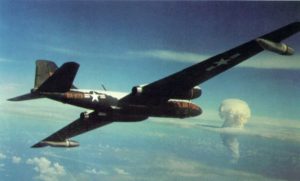 Hardtack Juniper
Hardtack Juniper
Hardtack represents the end of nuclear testing in the Marshall Islands after 12 years, 67 separate blasts, releasing the equivalent of a Hiroshima-sized weapon every day for twelve straight years. But they’re not done with these islands just yet. The Marshall Islands have been in the middle of what amounts to an undeclared nuclear war where one side has no weapons at all. It’s been calculated that the combined fallout from the tests totals a staggering 3000 times that released during the Chernobyl disaster plus Three Mile Island, plus all that released from the Hanford Reservation where much of the plutonium for these weapons was processed.
 Hardtack Umbrella
Hardtack Umbrella
Between 1958 and 1976, Enewetak Atoll continued to be used for various U.S. Department of Defense programs in the northern islands. The cleanup program began in May 1977. During the 1960s, Enewetak Atoll was a primary target location for testing of intercontinental ballistic missiles and would be used for developmental tests of high energy upper stage rocket motors, further contaminating the northern islands with beryllium.
1963 : Rongelapese people begin to develop thyroid tumors. Children’s growth is noticeably retarded. Three years later 35% of the population has some form of thyroid abnormality. This year also sees a polio epidemic in the Marshalls, imported by a US inhabitant, resulting in 196 cases of paralysis. The islands see their first suicide cases, totally unknown before.
1967-8: The Enewetak people living on Ujelang Atoll nearly starve, when the few crops available are attacked by a huge population of rats on the island. In a scenario remarkably similar to the one after the Baker test and the people on Rongerik in 1946, Enewetak people living on Ujelang Atoll face starvation conditions. A supply ship eventually arrives but is short of goods. Some islanders board the ship and refuse to leave, saying they wish to abandon Ujelang. Ataji Balos, a government official agrees to stay on Ujelang with the people until a new supply ship returns with sufficient food. A second ship, with sufficient supplies finally returns two weeks later.
1968 : The AEC declared Bikini atoll safe for resettlement. This was, if not a brazen lie, then unbelievably naive. The Bikini Council rejected the idea of mass repatriation. A few families do return, however.
1969 : An eight-year plan is prepared for the proper resettlement of Bikini using plantations of coconut trees and phosphate fertilizer to soak up residual radiation. Clean-up of the atoll was split between the AEC and DoD. The work goes on through 1972 when it is discovered that elements of the food chain, like crabs and groundwater, have retained high levels of radioactivity, rendering the islands once more uninhabitable. A medical survey by Dr. Robert Conard of Brookhaven late in the year shows little difference in radioactivity levels among the exposed and unexposed Rongelap people living on the atoll. However, it’s known that as late this year the body radioactivity levels of previously unexposed Rongelap people was 10 times that of Marshallese living on Kili, meaning the uptake from the environment on Rongelap, although known, was being completely ignored.
1972 : In 1972, a decision was made to return Enewetak Atoll to the Trust Territory of the Pacific Islands (TTPI) for subsequent return to the people of Enewetak. This announcement committed the United States government to the survey, cleanup and rehabilitation of Enewetak Atoll. This year also sees the first radiological study of the atoll.
November 1972 : Lekoj Anjain dies in Bethesda, Maryland, of myelogenous leukemia. He is just 19. At the time of the Bravo test, he was one year old. He played in the snow that fell on Rongelap. His father, mother, and uncle all developed cancers as did many people in Uterik, a full 300 miles downwind of the Bravo test.
Clean-Up : 1972 -1980 : In what was labelled the Enewetak Radiological Support Project, over 8000 US servicemen from the army, airforce, navy and some civilians, are assembled – ‘voluntold’ in their own vernacular – to scrape the contaminated islands of their topsoil, gather other radioactive debris and put it all in the crater created by the Cactus test shot of May 5th, 1958. Then they constructed a massive concrete dome over the 110,000 cu. yds of highly radioactive material and mixed it with concrete to stabilize it. The dome is called variously, Cactus after the weapon that created the crater or Runit, the small island the dome sits on but the locals simply call it the Tomb. And there it sits to this day, looking for all the world, like a crashed flying saucer, in the middle of the remote Pacific. Much of the surface sand, military hardware, unexploded weapons and other ordinance were simply bulldozed into the lagoon where it sits as we speak. This loose material may pose more of a hazard than the actual contents of the dome. To save money, the dome was constructed without any form of a base lining. In fact, photos taken immediately after the Cactus test shot show the crater full of sea water. The atoll walls are entirely porous coral; sea water is free to enter – and exit – the crater with the tides.
At the time the dome was built it was thought that it would last a thousand years but no-one had consulted Edward Teller who, you will remember, had given a talk to the American Chemical Society, on global warming and rising sea levels. So, as we speak, we know there is sea water inside the dome. Stagnant water outside is as radioactive as the dome’s contents. We know, also, that locals in need of money to feed themselves, have gained access to the interior of the dome and retrieved metal to sell as scrap. That metal has been traced to the Far East, via its unique radioactive signature. As constructed, the Cactus dome would not pass muster as a domestic garbage dump on the continental US, let alone a repository intended to contain deadly radioactive materials for millennia.
1973 : An unpublished AEC draft report shows that 28 of the Marshall Island atolls were contaminated by the Bravo test to one degree or another. Brookhaven laboratory, which performed much of the medical research, reported that twenty out of the twenty-nine Rongelapese children under ten years old at the time of the Bravo test had developed thyroid tumors.
1974 : Three Bikini families returned to the atoll but were evacuated again in 1978 because of high levels of radioactivity in their bodies from four years of eating contaminated food.
June 1975 : A Dept. of the Interior study backtracks from previously declared positions and finds alarming levels of radiation still present on Bikini. In October, Bikinians file suit to have a complete radiological survey completed.
1976 : The DoE repeats a study of the Rongalapese inhabitants and somehow finds alarming levels of radiological contaminants in the environment and food system that had been missed but does not reveal any of the findings to the islanders. In another little-noted addendum to the mess left behind by the nuclear testing program, because the traditional food system, based largely on crab meat, Pandanus, Breadfruit and copra or coconut meal is so tainted, the Marshallese people have become entirely dependent on imported canned goods from abroad. Unused to this type of diet, this has led, in turn, to a pandemic of diabetes in the population, the highest rates on the planet. With no insulin or dialysis treatment facilities on any of the islands, a huge percentage of the Marshallese population has some form of amputation due to their diabetes.
1977 : People on Uterik during the Bravo fallout incident begin to suffer thyroid cancers just as the Rongelap population did earlier. It just took longer.
March 30, 1978 : Kwajalein landowners and supporters reclaim an island in off limits “Mid-Corridor” area of Kwajalein lagoon to protest use by the Army. Handel Dribo, a landowner on Kwajalein said, “for 12 years my land was used by the military. l have not received one penny.” The Army goes ahead with a missile test regardless of the fact that protesters occupy an island in a hazardous area.
1978 : In September, the Bikinians are uprooted once again, and returned to Kili.
June 19, 1982 : Kwajalein landowners organize a massive sail-in protest called “Operation Homecoming” to demonstrate against the terms of the Compact of Free Association. More than 1,000 Marshallese stage a resettlement protest, occupying Kwajalein Island and eleven other islands on the atoll. This forces the cancellation of at least one missile test. The Marshallese people establish two camps on Kwajalein itself, making it clear that this is their land. In a brazen display of authoritarianism, the army arrests 13 elected and traditional Kwajalein leaders and cuts off communications, food shipments, and water to the campsites – on their own land. To make it clear that the people were not in control of their own territory, the soldiers begin daily body searches of Marshallese employees at the missile base and erect barbed wire, search lights, and a fenced-in checkpoint, all contrary to agreements made. When this fails to dislodge the protesters, the US tries to bribe them with Coke and ice cream. Eventually, the US is forced to make some concessions but then, fails to live up to them, proving once again, that any agreement with the US isn’t worth the paper it’s printed on.

Evacuation of Rongelap Islanders to Mejato by crew Rainbow Warrior. Members of the RW crew help islanders onboard.
May 1985 : With an ever increasing number of its inhabitants falling sick, the Rongelap people elect to leave their homeland once again, to seek refuge on a small island in the Kwajalein atoll chain called Mejato. They are evacuated by the Greenpeace ship, Rainbow Warrior.
November 3, 1986 : The Compact of Free Association is signed, though with considerable resistance throughout the RMI. The Compact was sold to the islanders as a 15-year bridging arrangement until it was deemed they were ready for genuine independence but included a backdoor clause, allowing the US unfettered access to Kwajalein, in perpetuity. Essentially, the Marshall Islands had become a permanent US base. The Empire had just expanded.
As Jane Dibblin, a British journalist noted during a visit in 1988:
‘While the Compact promises independence . . . it is, in fact, a virtual U.S. annexation of the islands for military purposes, a denial of self-determination and a shrugging off of responsibility for past actions. The U.S. has “full authority and responsibility for security and defense matters”. . . . The governments . . . are required to “consult” the U.S. over foreign affairs . . . The U.S. can veto any item of domestic or foreign policy or any business or trade agreement which it deems is threatening to its security . . . U.S. security interests overshadow every other consideration. Self-determination is a mere gloss.’
1987 : A study looks at the Marshalls Islands as a possible site for the long-term storage of all the US’s radioactive waste, from power stations and weapons factories.
September, 1990 In a suit demanding recompense, the people of Enewetak islands claim that the US violated the United Nations trusteeship agreement and its own promises to care for them after they were moved off the atoll. They declare that a total of five islands of the Enewetak Atoll were partially or totally destroyed by tests while Runit was made uninhabitable because tonnes of plutonium-saturated sand and debris were dumped into a crater on the island and covered with concrete. They further charged the clean-up completed in 1980 did nothing to repair damage to the atoll’s lagoon. Long-term damage to the agricultural productivity of the atoll was caused by the removal of extensive amounts of plant material and topsoil that were contaminated with plutonium. 
Present Day – The base on Kwajalein is not going anywhere. As the largest atoll on Earth, it presents an irresistible target for unarmed US ICMB’s. They are regularly hurled from Vandenburg AFB in California toward Kwajalein, either to be intercepted by anti-missile projectiles fired from the base or to slam into the lagoon. The 2015 batch of ICBM tests arrived on May 20, Aug. 19, Oct. 21 and Nov. 9. The atoll has only gained in strategic significance to the US as it keeps a wary eye on China and North Korea. The election of President Trump has done nothing to ease tensions in the region. Each missile test is purported to cost $100,000,000. The Americans that live on Kwajalein have a lifestyle very much like that of beachfront property owners in Miami.

The base is full of US citizens but serviced by 1200 islanders, who live on a sliver of land a tenth of a square mile in area, called Ebeye, total population 10,000+. As of 2003, the other 90% of the Ebeye population is unemployed. Jane Dibblin, posited that Great Britain would need to accommodate twice the entire world’s 1988 population, amounting to 10 billion people, to achieve the same population density.
As of 1977, more than 13 people live in each single room unit on Ebeye, and in extreme cases up to 40 people in one unit. Many of the people are refugees from Rongelap and their offspring. Ebeye is so densely populated and unsanitary that diseases like polio and TB have become frequent. It’s known a The Slum of the Pacific. There is no sewer system and no running water. Many observers have deemed it apartheid in the Pacific.
Games on Ebeye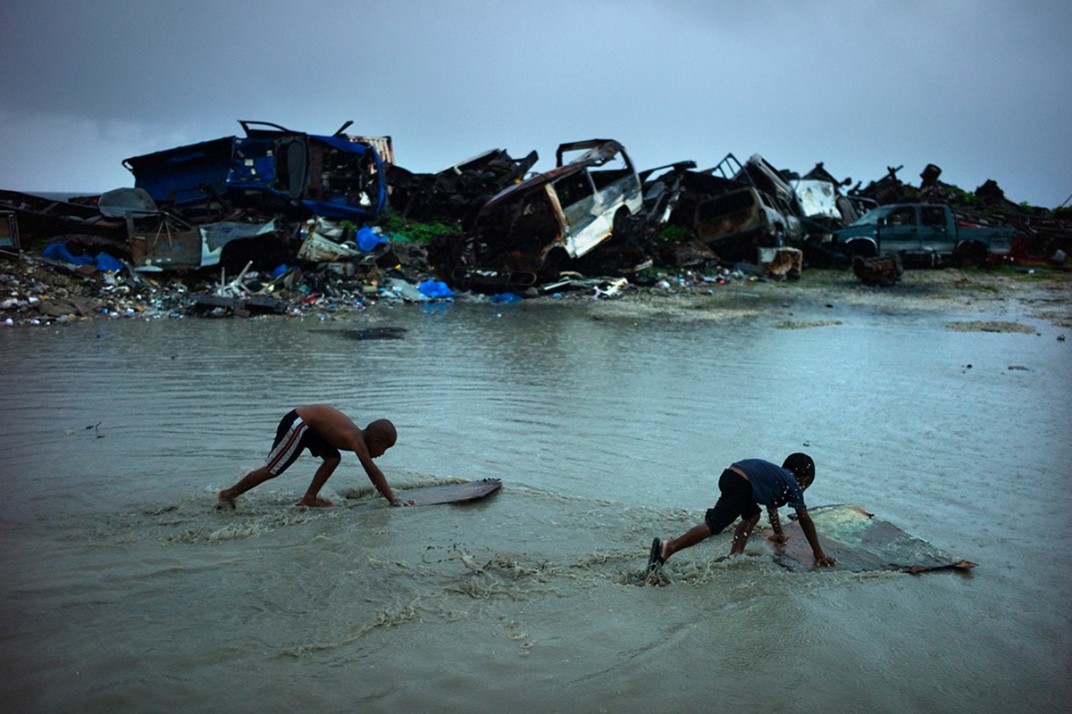
Many islanders, Tony De Brum, ex-RMI foreign minister foremost among them, would argue that it doesn’t matter how much money the US has shelled out in the recent past. The Republic of the Marshall Islands has had it’s future eviscerated; how do you make recompense for that? How much is enough for a nation’s hope for its own offspring. The Marshall Islands are experiencing global warming and rising sea levels now. For these people, this is no hoax. In 2014 a thousand people had to be evacuated from Majuro as king tides ripped houses off their foundations and tossed them into the sea. The islands are economically dependent on the US (a situation the US was only too happy to engineer) so the RMI government has little in the way of leverage when it comes to bargaining for their own rights and the future of the islands. Such is the misery of some Marshallese communities, with the multiple threats of cancer, poverty, stillbirths, diabetes and now, rising sea levels that they have elected to forego procreation, in short, to allow themselves to die out altogether.
The Bikinian Anthem
No longer can I stay, it’s true
No longer can I live in peace and harmony
No longer can I rest on my sleeping mat and pillow
Because of my island and the life I once knew there
The thought is overwhelming
Rendering me helpless and in great despair
